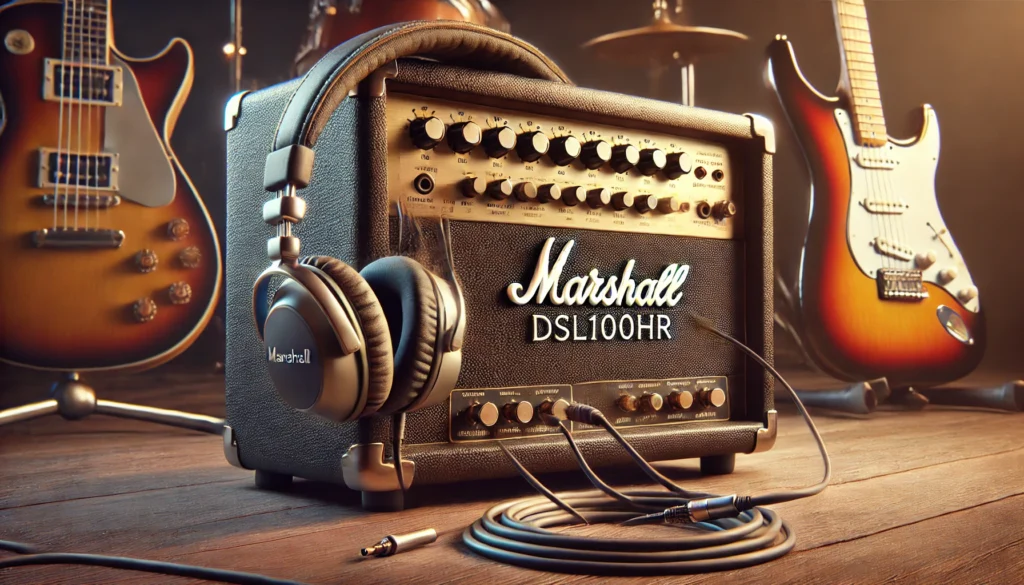Beginning:
Renowned sound quality defines Marshall amplifiers, which makes them a first choice for musicians, whether for practice or performance. Part of Marshall’s well-liked DSL series, the DSL 100HR Marshall amp offers remarkable tonal quality and adaptability. What if, however, your DSL 100HR calls for headphone use? Knowing how to correctly connect your headphones to this mighty amp will improve your experience whether you are practicing late at night or wish to avoid bothering others.

Providing useful information and recommendations to maximize your configuration, this post will walk you through using headphones with the DSL 100HR Marshall amp. Let’s get into the specifics!
Contents Table:
- Why Should Your DSL 100HR Marshall Have Headphones?
- Which Kind of Headphones Complement the DSL 100HR Marshall Most?
- Connecting Headphones to the DSL 100HR Marshall: A Step-by-Step Guide
- Changing the Tone for Headphones
- Typical Problems with DSL 100HR Marshall Headphone Use
- Frequently Asked Questions
- Final Thoughts
1. Why Should You Use Headphones with Your DSL 100HR Marshall?
Headphones with your DSL 100HR Marshall provide several advantages that could significantly enhance your practice sessions. Here are a few justifications for choosing headphones:
- Silent Practice: Many artists wear headphones for silent practice, hence this is their main motivation. Perfect for late-night sessions or for apartment life, headphones let you rock out without bothering others.
- Focused Listening: With headphones, you can hear every detail of your performance. Headphones offer a more concentrated listening experience than speakers whether your goal is for mixing or honing your expertise.
- Convenience: You don’t have to bother about configuring an outside speaker system or coping with volume limits. You’re good to go if you just plug in your headphones.
2. Which Kind of Headphones Complement the DSL 100HR Marshall Most?
Most wired headphones will fit the DSL 100HR Marshall’s standard 1/4-inch headphone output. For the greatest audio experience, nevertheless, certain kinds of headphones perform better than others.
- Impedance Considerations: The impedance of headphones has a major impact on how they sound when linked to your amp. Headphones in the impedance range of 32 ohms to 250 ohms suit the DSL 100HR. While lower impedance headphones could produce a harsher sound, if your headphones have a higher impedance, you may find a quieter sound or limited volume.
- Closed-back vs. Open-back Headphones: Closed-back headphones offer superior noise isolation, which is perfect for practice sessions in loud surroundings. Conversely, open-back headphones provide a more natural sound but let noise out, thus they are less appropriate for practicing in shared environments.
- Over-Ear vs. On-Ear: For extended practice periods, over-ear headphones are usually more comfortable and provide better sound quality. Though they may not offer the same degree of comfort or sound isolation, on-ear headphones are more portable and small.
3. Connecting Headphones to the DSL 100HR Marshall: A Step-by-Step Guide
Though there are several procedures to guarantee the optimum quality and performance, connecting your headphones to the DSL 100HR Marshall is really easy.
- Step One: Get the headphones and amp ready: To prevent any damage, ensure your DSL 100HR is off before connecting any devices. Choose a set of headphones with the suitable impedance and connection choices.
- Step Two: Find the headphone output: Near the output area, the front panel of the DSL 100HR has a 1/4-inch headphone connector. Your headphones will be plugged here.
- Step Three: Link Your Headphones: Plug the 1/4-inch jack of the headphone into the amplifier’s headphone output. Make sure the link is strong.
- Step Four: Turn on the amp: Your headphones should be connected in before you turn on the DSL 100HR and set the volume to a comfortable level. Remember that the headphone output skips the speaker, thus you may safely play without concern about speaker output.
- Step Five: Change Amp Settings: Shape your sound using the tone controls just like you would with normal speaker output. Remember to change the gain and EQ settings to fit your taste.
4. Changing the Tone for Headphones
Since using headphones with the DSL 100HR Marshall could sound a little different than using speakers, it’s crucial to change your tone settings for best sound. Here are some suggestions for audio fine-tuning:
- Gain Settings: The headphones could amplify the gain levels, so if the sound gets too distorted, think about reducing the gain. Especially if you’re playing quick lead lines or complicated chords, a somewhat lower gain can offer a clearer sound.
- EQ Adjustments: Headphones frequently concentrate the mid-range frequencies, so you might want to drop the mids slightly and raise the bass for a broader sound. But don’t go too far since that can cloud the sound.
- Presence Control: The DSL 100HR has a presence control that influences the upper frequencies. Change this setting to your liking to increase clarity or warmth.
5. Typical Problems Using Headphones with the DSL 100HR Marshall
Although usually simple, using headphones with your DSL 100HR Marshall could cause certain typical problems for musicians.
- Low Volume: Your headphones may be too quiet if the impedance mismatch is the cause. To drive headphones with a greater impedance effectively, more power could be required. Adjust the volume on your headphones and the amplifier.
- Sound Quality Problems: Check your tone settings if you see distortion or bad sound quality. Keep in mind that headphones can accentuate undesirable frequencies; thus, adjusting your amp’s EQ will help to obtain the optimal sound.
- No Sound Output: Make sure the headphones are firmly connected to the headphone jack. Check the output parameters of the amplifier as well as its correct switch to headphone mode.
READ ABOUT:Razer Tarok Pro Gaming Chair – Black: The Best Gaming Chair for Comfort and Performance
6. Frequently Asked Questions
Q1: Will the DSL 100HR Marshall work with wireless headphones?
A: The DSL 100HR Marshall lacks Bluetooth or wireless capabilities, hence you’ll have to utilize wired headphones with a 1/4-inch connection.
Q2: Will a headphone amp improve sound quality?
A: Though you may want to improve sound quality or use high-impedance headphones, the DSL 100HR has enough power for most headphones; a headphone amplifier could help.
Q3: May I keep my headphones connected when not in use?
A: Leaving your headphones plugged in is okay; just be sure to switch off the amp to avoid any unintentional power surges.
Q4: May I wear headphones with the DSL 100HR and the speakers linked?
A: Certainly, but before using headphones you must unplug the speaker from the amp. Most amps, like the DSL 100HR, only let one output at a time.
Q5: Will wearing headphones change the quality of my guitar?
A: Headphones could alter the tonal qualities in comparison to speakers, but with the right gain and EQ tweaks, you can get a great sound specifically for headphones.
7. Final Thoughts
For musicians who wish to practice quietly, concentrate on their tone, or investigate their sound in more depth, using headphones with your DSL 100HR Marshall amp can be a game-changer. The right headphones and correct configuration will let you enjoy all the wonderful features of this strong amplifier without bothering anyone nearby.

